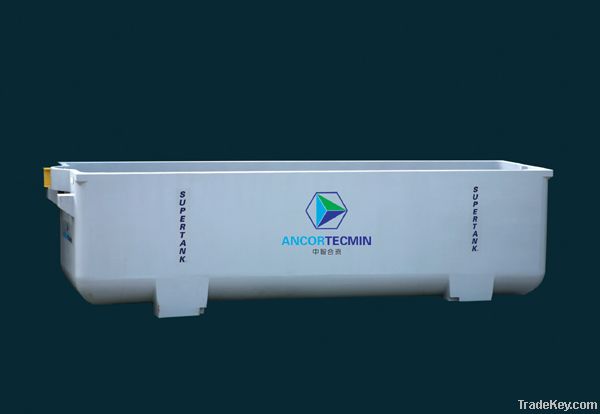Super tank Polymer Concrete Electrolytic Cells are designed,
built and installed to satisfy the most stringent requirements
requested by tank house operators worldwide. In most case their
main request is to guarantee full operating availability
throughout the plant's lifespan, maximizing production of
high-purity metal (copper, zinc, nickel, cobalt, lead or other)
with absolute safety for people and the environment.
Additionally, electrolytic cells must accommodate changes for
continuous improvement of electrolytic process, integrating
efficiently with upgrades of complementary equipment such as
anodes, cathodes, cap boards, overhead crane, electrolyte
agitation systems, acid mist control devices, thermal
insulation, among many others.
Super tank electrolytic cells are cast monolithically based on
a patented, three stratum composite material system:
The internal stratum is a monolithic tank made with multiple
layers of fiber-reinforced vinyl ester resin (FRP) complying
with chemical barrier international norms that assure long term
impermeability and corrosion resistance.
The intermediate stratum is the structural core made with
Hyperbonded Polymer Concrete, with a patented formulation to
achieve a low coefficient of thermal expansion, providing long
term structural integrity with low thermally-induced stresses.
The external stratum is a standard seal layer of FRP that
further protects the structural core from electrolyte splashes
and spills. Optionally, this external seal may be specified
with multi-layered oriented fiber reinforcements to guarantee
trouble-free operation in unusually extreme operating
environments.
Super tank electrolytic cells are characterized by their
rounded shapes, optimized for aggressive thermal conditions
through successive iterations using computer simulations and
finite element analysis.
The Super tank design eliminates corners and sharp edges,
replacing them with smooth curves in the interior and exterior
junctions. Abrupt changes in wall thickness become gradual
transitions throughout the structure, mitigating stress
concentrations and reducing material usage and weight by ****5%
maintaining the cell’s holding capacity.
Benefits of super tank electrolytic
cells are as follows:
Guaranteed
Long-Term Impermeability, Free of Corrosion
It is designed with a monolithic impermeable internal tank
manufactured with multiple layers of fiber-reinforced premium
vinyl ester resin. The specifications for this internal tank
have been validated by proven impermeability and corrosion-free
service for over *0 years in the chemical processing industries
worldwide.
Manufacturer’s *0
Year Warranty
We guarantee Super tank cells for continuous service without
leaks, free of corrosion and structural flaws, operating under
normal conditions as specified for each Project.
Swift, Accurate and
Less Costly Installation
Super tank cells include features that allow reduction of *5%
or more in time needed for cell erection, alignment and
leveling, compared to time required with conventional polymer
concrete cells. Dimension tolerances for Super tank cells are
consistently tight, simplifying installation in the most
demanding applications, including plants with automated crane
systems.
Minimum Cleaning Time
and Water Consumption
The rounded internal shape, optional sloped cell floors, and
smooth, flat finish of the internal tank, facilitate water
sweeping and drainage of heavy sludge, with reduced water usage
and accelerating return to service after each cleaning.
Minimum Maintenance Cost
The robust, virtually impervious internal tank that is
chemically bound to the Hyperbonded polymer concrete structural
core during molding is tolerant to operating abuse. Its smooth,
non-stick surfaces minimize adhesion of contaminants.
Maximum Operational
Safety
The structural core of Super tank cells is bolstered with
sturdy external seismic reinforcement blocks confining its
floor supports, and includes a robust, internal bidirectional,
pultruded FRP bar mesh reinforcement which positively maintains
integrity should the cell fail due to catastrophic events.
Super tank cell installation protocols call for lateral wall
collaboration between cells, thus reducing stress levels of
cell around *0% under normal operating conditions.
Key Accessories
Integrated with Super tank Cell Engineering
We design and manufacture cell thermal insulation, capping
board and electrolyte agitation systems that can be
incorporated in the cells, enhancing overall safety, cathode
quality and tank house productivity.
Typical Cell Construction
Features
Super tank electrolytic
cells are manufactured with a proprietary “tri-stratum polymer
composite material”. This material consists of three
monolithically bound layers.
(1) An electrolyte FRP seal or chemical barrier
(2) A structural core made with Hyperbonded polymer
concrete (aggregate reinforcement grading according to US
Patents No. ******9)
(3) An external FRP seal.
The polymer concrete structural core and both FRP seals are
manufactured to ensure a high quality chemical bond between the
three strata, forming a cohesive, monolithic composite material
with very high chemical and mechanical strength. The
formulation and properties of this composite material have been
tailored for best performance electrolytic cells.
The electrolyte seal complies with the sections of norms DIN
*8.****3 and ASTM C**2 regarding chemical barriers for FRP
tanks. These forms have been validated by more than *0 years of
successful industrial experience. This seal typically consists
of three layers of fiberglass impregnated with vinyl ester
resin.
The external seal is manufactured with same care and quality as
the electrolyte seal, although with only one FRP layer it does
not comply with the above standards.
Both seals can be inspected according to norm ASTM D***7
Class IV. As an option the seals may be pigmented white, gray
or other color favorable to refinery operation or purchase
preference.
The Hyperbonded polymer concrete material offers improved
mechanical strength and excellent chemical and electric
resistance, compared to conventional polymer concrete. It has
also been formulated to reduce thermal dilatation that induces
high mechanical stress in electro-refining cells.
The Hyperbonded polymer concrete
material offers improved mechanical strength and excellent
chemical and electric resistance, compared to conventional
polymer concrete. It has also been formulated to reduce thermal
dilatation that induces high mechanical stress in
electro-refining cells.


